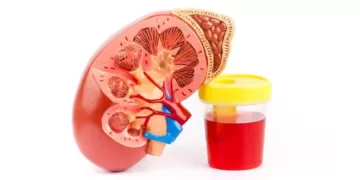Discharge in men may occur during gonorrhea, trichomoniasis, ureaplasmosis, mycoplasmosis, chlamydia, and nonspecific urethritis.
Before discussing these diseases, let’s review the physiological condition in which the presence of specific discharge is not considered pathological.
- During an erection, a specific secretory fluid is often discharged from the opening at the tip of the penis. This fluid is not the same as the one released during ejaculation. It is a clear drop and serves to lubricate the tip of the penis. Additionally, it reduces the acidity of the urethra, which means that the male ejaculate may cause pregnancy in a woman.
Sometimes men mix this secretory fluid with a drop of urine. It is very easy to distinguish between the two: urine is clear like water, while this secretory fluid is viscous. It may appear on the tip of the penis in the morning, before urination, or after.
- The second physiological condition is nocturnal emission (pollution). Nocturnal emission refers to the involuntary release of semen, usually during sleep, often following erotic dreams, and does not disrupt sleep. Nighttime emissions are common in adolescents and signify sexual maturation. They typically stop once regular sexual activity begins.
There is also daytime pollution, which occurs during wakefulness, mostly due to natural sexual-erotic arousal. Sometimes, daytime pollution is triggered by non-sexual stimuli, such as strong emotions, transportation vibrations, or acrobatic movements. Nighttime pollution can also occur in adult men.
This is usually a result of sexual abstinence. Pollution is a sign of normal hormonal activity of the sexual glands. When this happens frequently, it may indicate a disruption in the sexual sphere. In such cases, a visit to a doctor is necessary.
All other fluids that are discharged from a man’s genitalia should be tested by a specialist.
Urethritis (inflammation of the mucous membrane of the urethra)
A characteristic symptom of urethritis in men is discharge from the urinary-genital tract, but discharge can also be physiological.
As for urethritis, it can occur without discharge. It is very important to visit a doctor as soon as discharge is noticed.
Urethritis, along with discharge, is accompanied by dysuria (difficulty urinating) and irritation of the tip of the penis.
Urethritis is diagnosed by examining a urethral smear or the first portion of urine. Urethritis is often caused by gonococci, chlamydia, and others.
Gonorrhea
Gonorrhea manifests differently in men and women. Their only common feature is that the main symptom of the disease is discharge from the genital organs and sharp pain during urination.
In men, the symptom of gonorrhea is considered to be white or yellow discharge from the penis. However, the absence of discharge does not mean the absence of the disease. Discharge typically appears after the incubation period (2 to 5 days), although sometimes the incubation period is longer.
Recently, there has been an increase in cases where gonorrhea is asymptomatic. In other cases, after the incubation period, the characteristics of the acute form of gonorrhea appear.
The progression of the disease and the manifestation of symptoms primarily depend on which organ is affected by the gonococcus.
Most often, the urethra is affected, and gonococcal urethritis develops. By the way, this is characterized by discharge that leaves yellowish-green stains on the lower underwear.
Gonorrhea is quite a serious infection. If left untreated, it can lead to infertility, impotence, and other complications. It is essential to start treatment as early as possible, as self-medication can lead to serious complications.
Trichomoniasis
Trichomonas is a single-celled organism capable of surviving not only inside the body but also outside of it.
In addition to the harm it directly causes to the body, Trichomonas has the ability to engulf gonococci, without damaging them. When Trichomonas moves from one person’s body to another, it carries the “swallowed” gonococci with it. Incomplete treatment can lead to the development of gonorrheal infection after trichomoniasis is cured.
In men, trichomoniasis often occurs without symptoms. A man can be a carrier of trichomoniasis throughout his life, infecting his partners while experiencing no discomfort himself.
Inflammatory processes are rarely observed in the urethra, prostate, seminal vesicles, and testes. Sometimes, cloudy white discharge from the urethra or traces of blood in the urine are noticed. This lasts for 1-2 weeks, after which symptoms decrease, but the disease continues and can progress into a chronic form.
Ureaplasmosis
Ureaplasma is a microorganism that is considered a transitional stage between viruses and single-celled organisms. Infection with this organism often occurs through sexual contact. Additionally, it can be transmitted from mother to child during childbirth.
The incubation period of the disease typically ranges from 4 days to one month, although it may last longer in some cases. After the incubation period ends, the first symptoms of ureaplasmosis appear.
It should be noted that ureaplasmosis often progresses almost unnoticed, and sometimes entirely without symptoms. This type of progression is more common in women. In men, the most common symptoms of ureaplasmosis are slight transparent discharge from the genitalia, moderate pain, and a burning sensation during urination. Ureaplasma infection of the prostate manifests with symptoms of prostatitis.
Mycoplasmosis
Urogenital mycoplasmosis is clinically not very different from other etiologies (gonorrhea, trichomoniasis) that cause damage.
Some patients have no subjective symptoms, while others display a full range of symptoms. In cases of damage to the urinary-genital tract, men may experience slight discharge in the morning.
Chlamydia
Chlamydia is slowly taking the title of the “plague of the 21st century” from other sexually transmitted diseases. According to the WHO, the spread of this infection resembles a snowball effect. This disease is primarily transmitted through sexual contact.
In men, every second case of urethritis is of chlamydial origin. The symptom of chlamydia in men is discharge from the urethra. The discharge is typically small in quantity, transparent, and is accompanied by mild pain during urination. In children (boys), along with the discharge from the urethra, itching in the genital area can also be observed.
Nonspecific Urethritis
Nonspecific urethritis is inflammation of the urinary tract, caused by microorganisms different from gonococci, chlamydia, trichomonas, ureaplasma, mycoplasma, and the herpes virus.
In venereology, this is one of the most interesting and least studied areas. Suspecting nonspecific urethritis is necessary whenever any symptoms of urethritis are observed (discharge from the genitalia, pain, and burning during urination).
Gardnerellosis
Gardnerellosis is vaginal dysbiosis. According to some specialists, it should not be directly considered a disease in men. However, it is a fact that Gardnerella, the cause of Gardnerellosis, can induce inflammatory processes in the male body.
Gardnerella enters the male genital system during sexual contact. Since it is not a “natural inhabitant” of the male genital tract, Gardnerellosis may be considered a sexually transmitted infection.
Gardnerella often enters the male body and typically leaves the genital system within 2-3 days. Chronic carrier status of Gardnerella is rare, during which tests are always positive, but no symptoms of the disease are observed.
In 9 out of 10 cases, Gardnerellosis does not manifest in men. The danger is that male sexual partners may become infected without even realizing it. In classic cases, the causative agents, when they enter the urethra during sexual intercourse, cause a mild inflammatory process of the mucous membranes. At this stage, a greenish discharge may occur from the genitalia, which is less bothersome to the patient.
However, the condition can worsen—Gardnerella can cause urethritis, which manifests as burning and pain during urination. Additionally, the discharge has a characteristic (fishy) smell. In such cases, treatment for Gardnerellosis is necessary.
As for other cases: Since harmless Gardnerellosis in men can become the cause of infection for their sexual partners, treatment for this disease is always required.
Prevention of all the diseases listed above is very simple and effective:
A healthy lifestyle, fidelity of partners, healthy nutrition, avoiding overwork and stress. Paying a little attention to yourself will help you avoid many unpleasant situations. Finally, if there have been changes in the discharge from your genitalia, do not wait for everything to “pass on its own.”
Only a specialist can accurately assess whether this is normal. Make sure to visit a doctor and ensure that you are healthy.
If there is a problem, it can be easily, quickly, and cheaply treated, as long as it is addressed in the early stages. Timely visits to the doctor are a guarantee of your health.
Karazanashvili’s Robotic Center offers treatment for urological pathologies using methods that meet the standards of world medicine.











